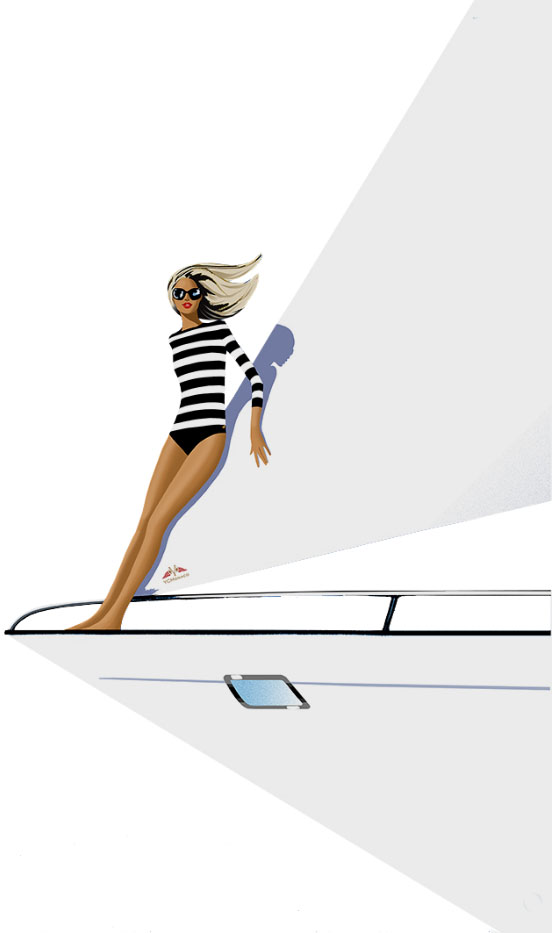
Get strong at sea with these yoga moves which we performed onboard 51m IRISHA
How to do yoga on a yacht
Yachting is one of life’s ultimate leisure activities. Although there is plenty to enjoy about lounging onboard while admiring the coastline, life on the water can also be an enormous opportunity to integrate wellness and fitness into your routine. Bringing a fitness instructor onto a yacht’s staff is becoming more common, as health and wellness offerings have become treasured add-ons to any leisure experience.
We teamed up with Lauren Coles, Founder and CEO of Yoga Yacht, to share a yoga routine you can try onboard, with or without the assistance of an instructor. Below are easy instructions to make yoga part of your daily yachting routine.
1. Work With the Water
Whether you are a beginner or experienced yogi, postures onboard present an array of challenges. The motion of the water’s natural rhythm and the size of the ship in relation to the water are factors you should be aware of before you start practicing. It is important to modify your routine on a boat to be safe, especially if you are a beginner.

Due to the motion of water, even mountain pose (pictured here) can present a challenge
Be sure to set yourself up near something stable, like a wall or a railing to assist with your balance for standing poses. If you’re experiencing a lot of motion on board, due to wind or choppy waters, stay closer to the ground, for less risk of losing balance.
Easy Seat, simply sitting cross-legged on the ground, presents many opportunities to stretch and connect with your body, no matter the motion of the ocean.
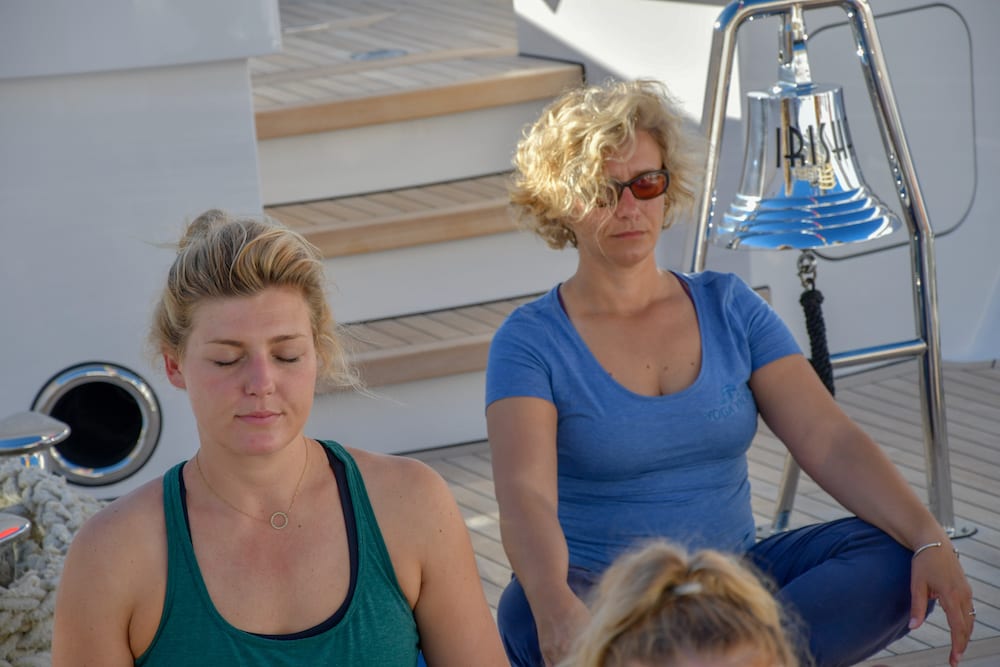
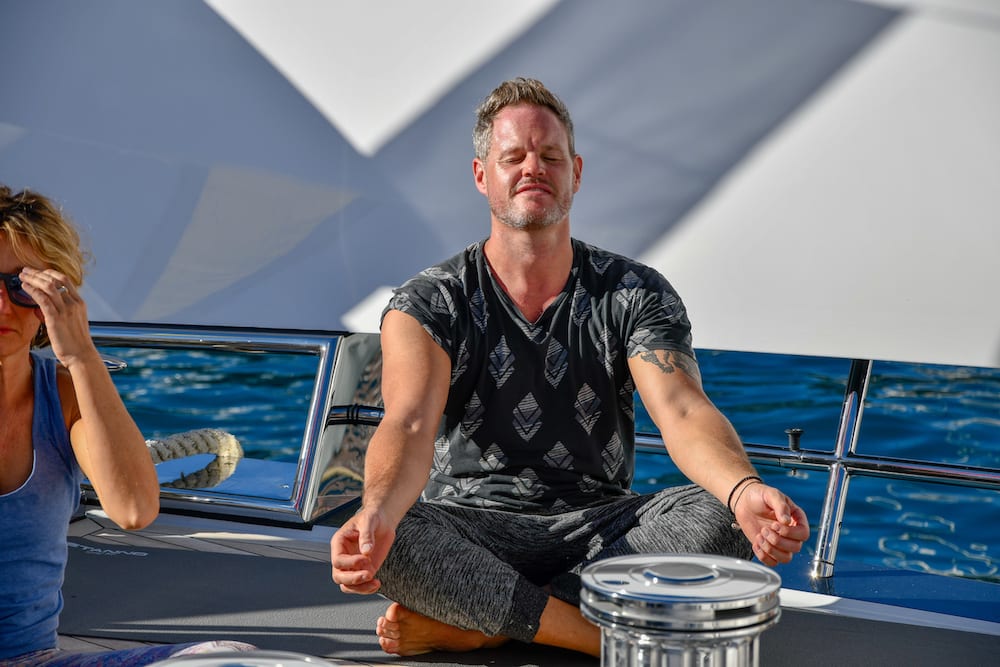
Easy Seat is simply being seated with legs crossed
2. Keep it Basic
When you first start practicing yoga onboard a yacht, the most basic parts of a yoga routine take on a new form. By connecting with your body, and embracing the newness that can come to your yoga practice from doing yoga on a yacht, you’ll enter the yoga experience with a fresh perspective.
A simple “Vinyasa” or flow — Downward Dog, to Plank, to Cobra or Upward Dog, back to Downward Dog, will seem completely foreign, as you adjust to moving through it with the ebb and flow of water.
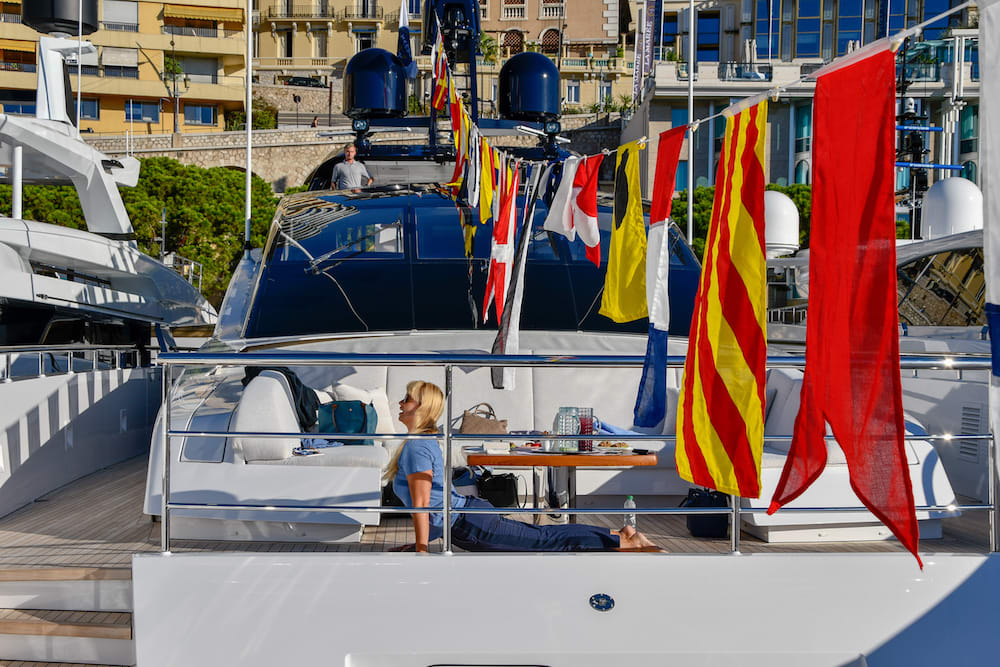
A simple Vinyasa: Downward dog, to plank pose, to upward dog
Explore these poses, either quickly with one breath per movement, as might be instructed in a traditional Vinyasa style class, or six or more breaths per movement, more common in the Hatha style. The most important thing about yoga is connecting with yourself, and the most important thing about yoga on a yacht is feeling safe and balanced. These poses allow you to stay sturdy with four limbs on deck, but remember to take your time if needed!
3. Challenge Yourself
Once you’ve become familiar with the motion of the water and its effect on your boat, know that it can change moment to moment. One of the most beautiful parts of a regular yoga practice is noticing changes in our mind and body, and embracing them without judgement. When we get into standing poses onboard, it’s important to let go of the ego, especially if we are used to practising yoga on dry land.
Warrior 1 might be basic poses on land, but notice how the soft lull of the sea challenges every muscle in your limbs to engage as you work on keeping your balance.
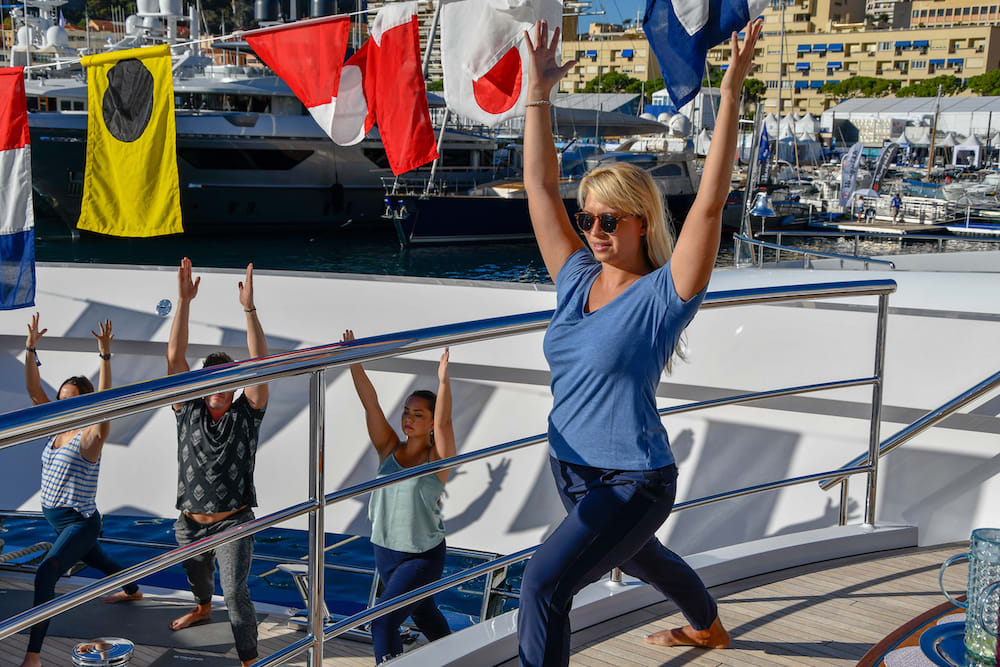
Warrior 1 on Heesen Yacht’s IRISHA. This move presents a challenge to your balance when performed onboard
As you gain more experience and feel more comfortable practicing yoga onboard, you may feel ready to begin to try balancing poses. The beginner-friendly Tree Pose can feel like an incredible challenge, depending on the motion you are experiencing onboard. To prevent yourself from stumbling out of the pose, keep your eyes focused on one point in space, known as a drishti in sanskrit, to help you maintain your inner balance with the motion of the ship.
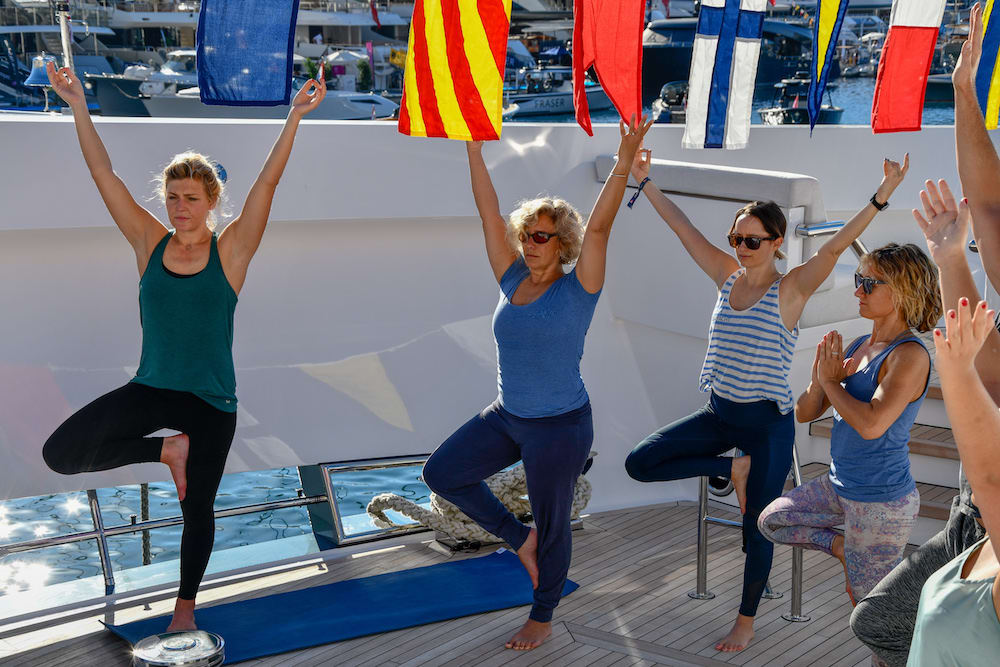
Practicing Tree Pose onboard IRISHA
You can play with variations of the pose, such as Figure 4 Balance, and get a nice opening in the hips.

Practicing a Figure 4 balance
The key with balancing poses onboard a yacht is to be aware of yourself and your surroundings, to get the most benefit out of the practice, while remaining safe.
4. Rest and Restore
Being low to the ground is the safest way to practice yoga on a yacht. Sometimes, weather and water conditions make it difficult to spend a lot of time trying to balance. These poses, while more meditative than physically challenging, offer a lot of relaxation benefits.

Bound Angle Pose with a forward fold
Bound Angle Pose is an excellent way to open up the hip joins and calm the mind. Sitting with your feet together and knees apart, feel the hips opening. You can sit up straight, or fold forward gently, as pictured below. Hold this pose for a few breaths, or a few minutes.

Practicing Bound Angle Pose
Reclining twists offer an opportunity to release tension in the spine while calming your mind. You can hold the twist for a few breaths, or up to 15 minutes, on each side.
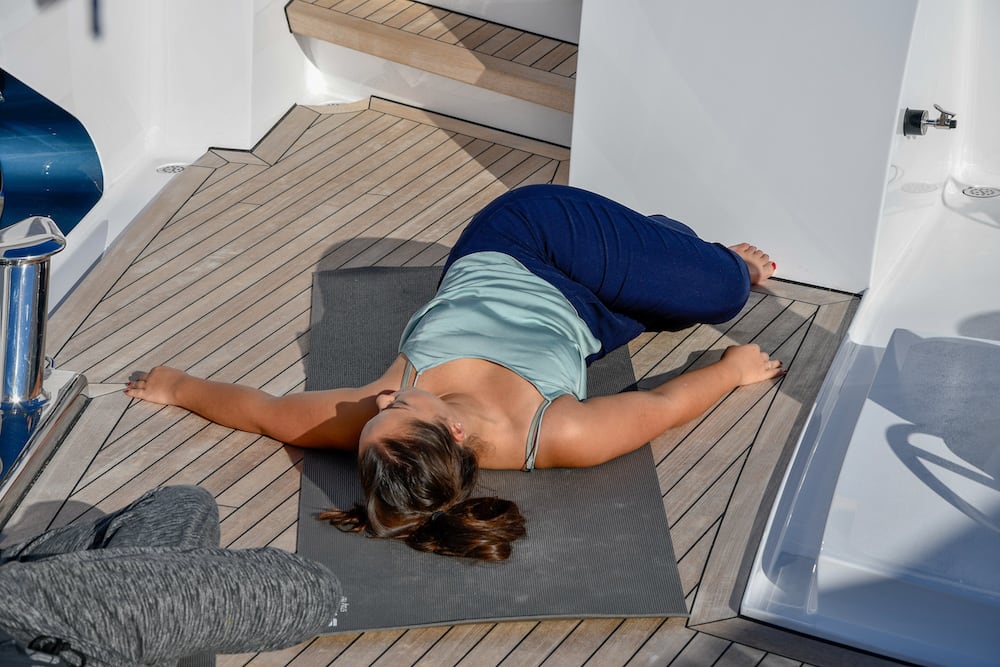
Reclining twist is an easy way to restore while observing the movement of the waves
Savasana, known as Corpse Pose, is the ideal way to end any yoga routine. It is the simple act of lying still on the ground, bringing your awareness internally to your breath and body. Ideally, your body will be in a relaxed state while your mind is still fully aware. Hold this pose for 5-30 minutes at the end of your yoga session to finish feeling refreshed.

Often, a teacher will take you on a guided relaxation during Savasana
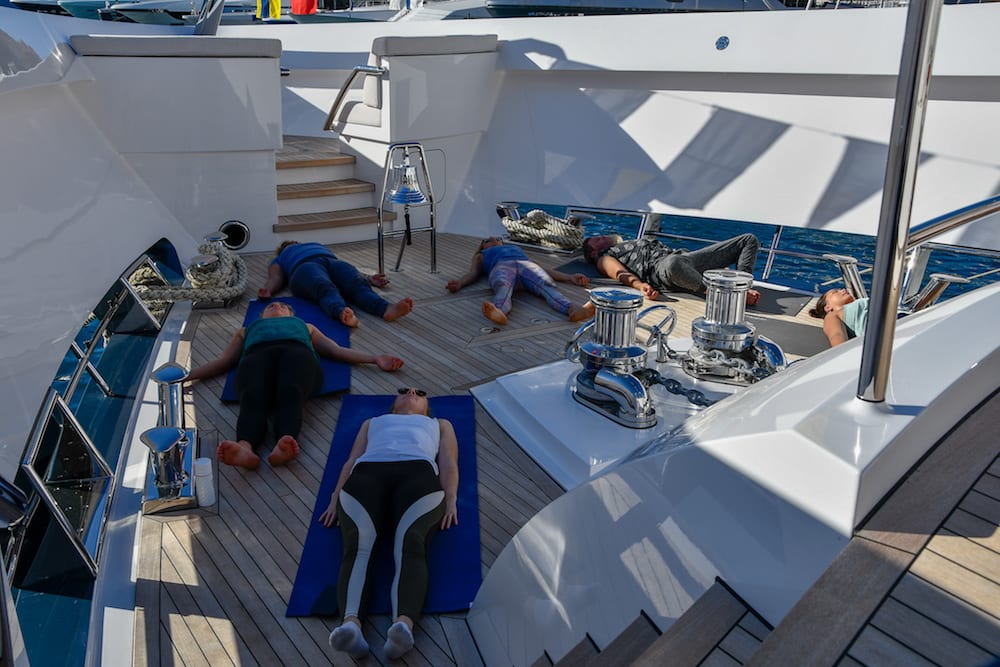
A yoga session almost always ends in Savasana
Whether you are completely new to yoga or practice regularly, yoga on a yacht is a worthwhile experience. Onboard, you are standing on the fluid motion of water, shifting your perspective. Poses that you may be accustomed to on land present new challenges. Additionally, the calm views and scent of the sea breeze present a calming effect that is impossible to replicate anywhere else. The next time you are onboard a yacht, I invite you to try a little yoga!
Lauren Coles is the Founder of Yoga Yacht, a company that provides customised yoga retreat services and events on yachts worldwide. Her goal is to help people connect with themselves through yoga, and connect with enjoying life on the ocean while minimizing our impact on marine life. Lauren can be reached at hello@yogayacht.org or @msyogaceo on Instagram.
